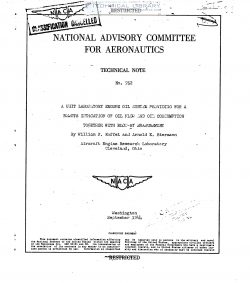naca-tn-952
- Version
- 186 Downloads
- 735.64 KB File Size
- 1 File Count
- December 1, 2016 Create Date
- December 1, 2016 Last Updated
National Advisory Committee for Aeronautics, Technical Notes - A Unit Laboratory Engine Oil System Providing for a Remote Indication of Oil Flow and Oil Consumption Together with Blow By Measurement

A unit oil system and oil—weighing device designed for labora-
toryengine tests to permit the remote measurement of oil—flow rate
and oil consumption is described. The systemregula-tes the Oil
pressure and temperature and is'closed to make possible the accurate
measurement of blow—by gas. The oil is, weighed by a self—Contained
diaphragm and pilot-valve assembly, which uses compressed air as
the transmitting medium. Several of these unit systems have given
satisfactory service for more than a year.
A unit oil system and oil—weighing device for laboratory test
engines was developed during 191.12 and 191;} by the Fuels and Lubri—
cants division of the NASA. The Object of this development was to
provide an accurate semiportable laboratory oil system of the closed
type for the measurement of blow—by gas and the elimination of fumes.
A remote means of indicating oil flow” and oil consumption was pro-—
vided in order that the oil system might be placed below the test
engine to permit the use of a gravity Oil return, which would obviate
the need .for a scavenge pump with its consequent foaming.
A single-cylinder—engine oil system with connections to the_
test engine and closed piping circuit for blow—by me,asi1rement is
shown schematically in figure 1. zifhe main components of .the oil
system are oil—weighing tank and "signing—diaphragm assembly, oil
pump, oil—temperature-regulator System, and oil strainer. Oil
-flows by gravity, or is pumped from the engine sump to the top of
the oil-weighing tank from which it flows by gravity, to the lower
compartment. It is then pumped by a gear pump through the oil
heater-cooler system, which regulates the oil temperature, and
then back to the engine through a combined oil strainer and mani-
fold, which supplies lubricant to the various engine bearings and
spray jets. It will be noted that, although all the oil passes
through the oil heater, the flow divides on its way to the
temperature~regulating valve, some going through the oil cooler
and the rest flowing directly to the temperature—regulating valve.
The heating elements of the oil heater have a low-wattage
dissipation per unit surface area to avoid local overheating with
consequent deterioration of the oil. A thermoswitch at the outlet
of the oil heater turns off the heater when the temperature of the
oil reaches the desired value.
| File | Action |
|---|---|
| naca-tn-952 A Unit Laboratory Engine Oil System Providing for a Remote Indication of Oil Flow and Oil Consumption Together with.pdf | Download |

Comment On This Post